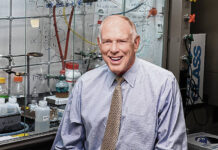SACRAMENTO, Calif. — Officials in charge of California’s slow-going high-speed rail project want to tap $4.1 billion in bond money to finish ongoing construction in the Central Valley, completing a segment of track that is just a fraction of the Los Angeles-to-San Francisco line voters approved the money for in 2008.
Project leaders presented the latest change on how to pay for the project — and what it will cost — on Tuesday to the California High-Speed Rail Authority’s board of directors. The new use of bond money, if approved, would go toward finishing 119 miles of track in the Central Valley. The state now expects to finish that construction by 2023, a year delay from the last proposal.
The coronavirus exposed vulnerabilities in the project’s funding plan, though construction is moving ahead, said Brian Kelly, the project’s chief executive officer.
“There’s no question we were hit,” Kelly said. “But it’s important to note, especially when you see the impacts of COVID-19 on the economy and jobs broadly, that this enterprise is creating jobs.”
The changes to the project’s business and funding plan will now go to a peer review group and state lawmakers for approval. The rail authority’s board voted to advance the new business and funding plan with the understanding that it must go through multiple other reviews and public comments.
“We’re starting a process,” board Chair Tom Richards said.
The plan could face resistance from lawmakers, who have grown more skeptical of the project in recent years.
“The voters approved this money for San Francisco to Los Angeles and instead we’ve blown through almost all of it,” said Republican Assemblyman Jim Patterson of Fresno, a longtime critic of the project.
Voters in 2008 approved a nearly $10 billion bond, with most of the money dedicated to “establish high-speed train service linking Southern California counties, the Sacramento/San Joaquin Valley, and the San Francisco Bay Area.”
But rail officials now want to take most of what’s left — about $4.1 billion — to finish the 119-mile segment of track from Madera to Bakersfield. That segment will run and test trains until a larger, 171-mile track is completed for passenger service from Bakersfield to Merced. Trains aren’t expected to be in service for passenger use until 2029.
The bond money would be used instead of revenue from California’s cap-and-trade program. Revenue from the program, generated by auctioning off credits needed to emit greenhouse gases, goes to a variety of projects including rail.
The auction revenue declined dramatically when the pandemic hit. The rail project previously received about $180 million per quarter in auction money, but the program generated just $6 million for rail during the quarterly auction last May, said Brian Annis, the rail project’s chief financial officer.
Revenue has rebounded since then, but officials see the bond money as a more stable source for construction needs in the short-term. The cap-and-trade money would then be tapped for future elements of the project.
“If we don’t obtain the (bond) funds we’ll have to slow construction,” Annis said.
Stuart Flashman, a lawyer in several cases against the project, said spending the rest of the money on the 119-mile segment of track in the Central Valley does not meet the original aims of the bond.
“Both the funding plan and the business plan continue to double down on the board’s decisions to build a part of a Central Valley segment that is still not going to be a usable segment,” Flashman said during public comment.
Newsom, the Democratic governor, prioritized getting a line in the Central Valley up and running, but lawmakers from both parties questioned whether a line through that part of the state made the most economic sense. Transportation analysts from Resource Systems Group, an outside group hired by the state to conduct a review, said Tuesday the Central Valley line made the most economic sense.
“We think an interim, electrified high speed rail system in the Valley is an important first step,” Kelly said.
Meanwhile, California can expect its communication with the federal government on the project to improve with Democratic President Joe Biden in office.
“As in many other arenas, California has taken the lead nationally to advance high-speed rail, starting an economically transformative project in the Central Valley and assuming the challenges that come with that leadership,” Amit Bose, the acting Federal Railroad Administrator, said in a statement.




